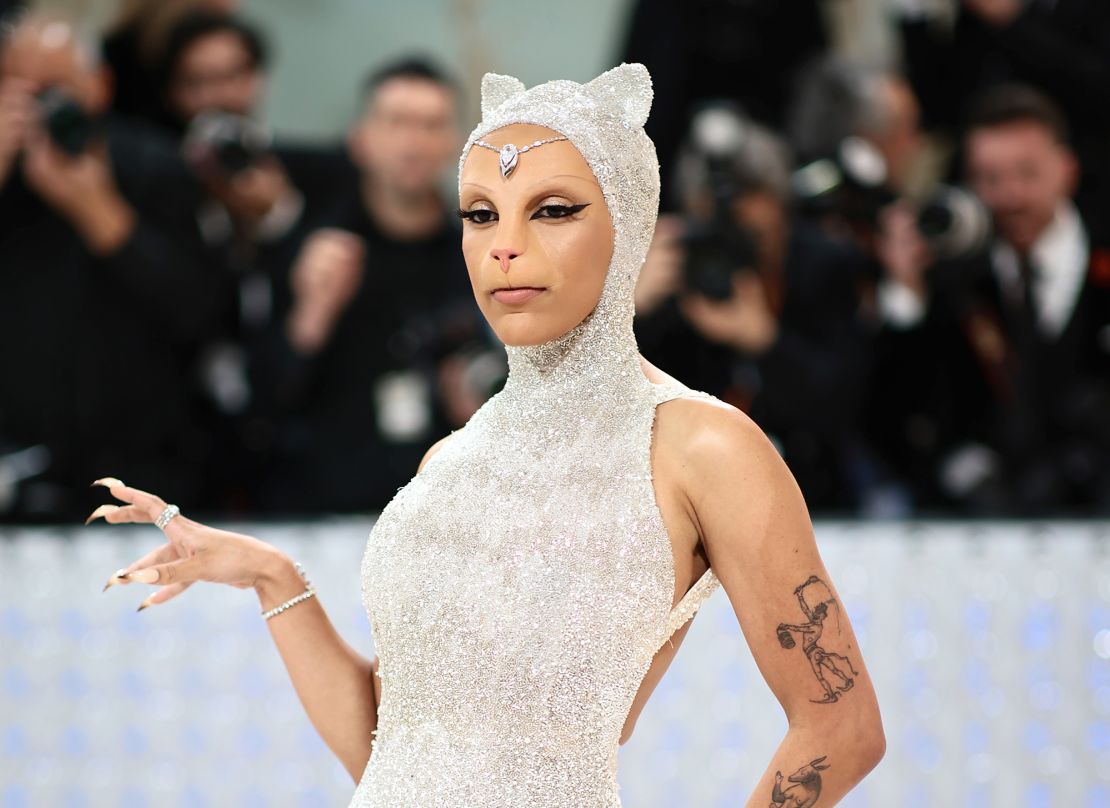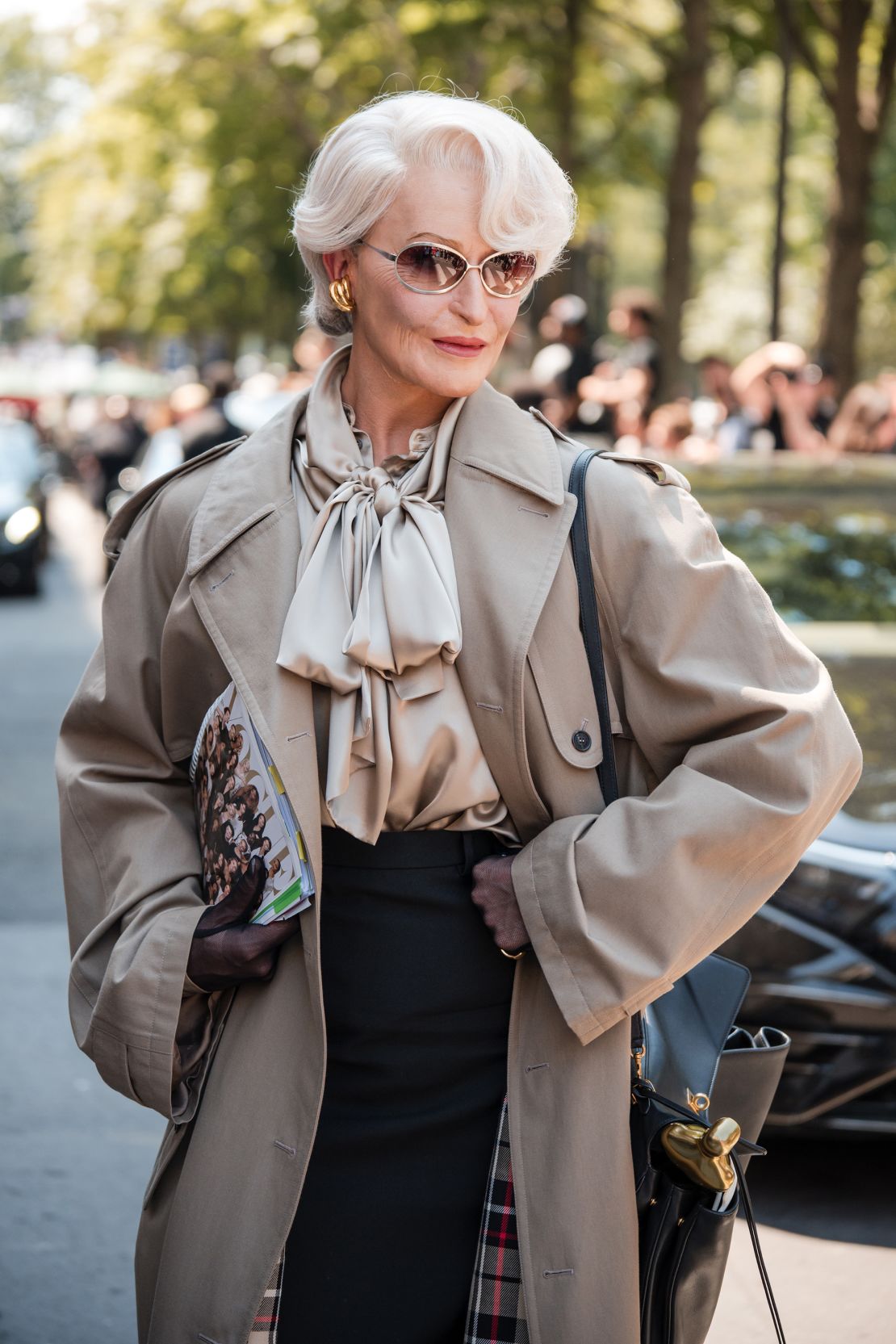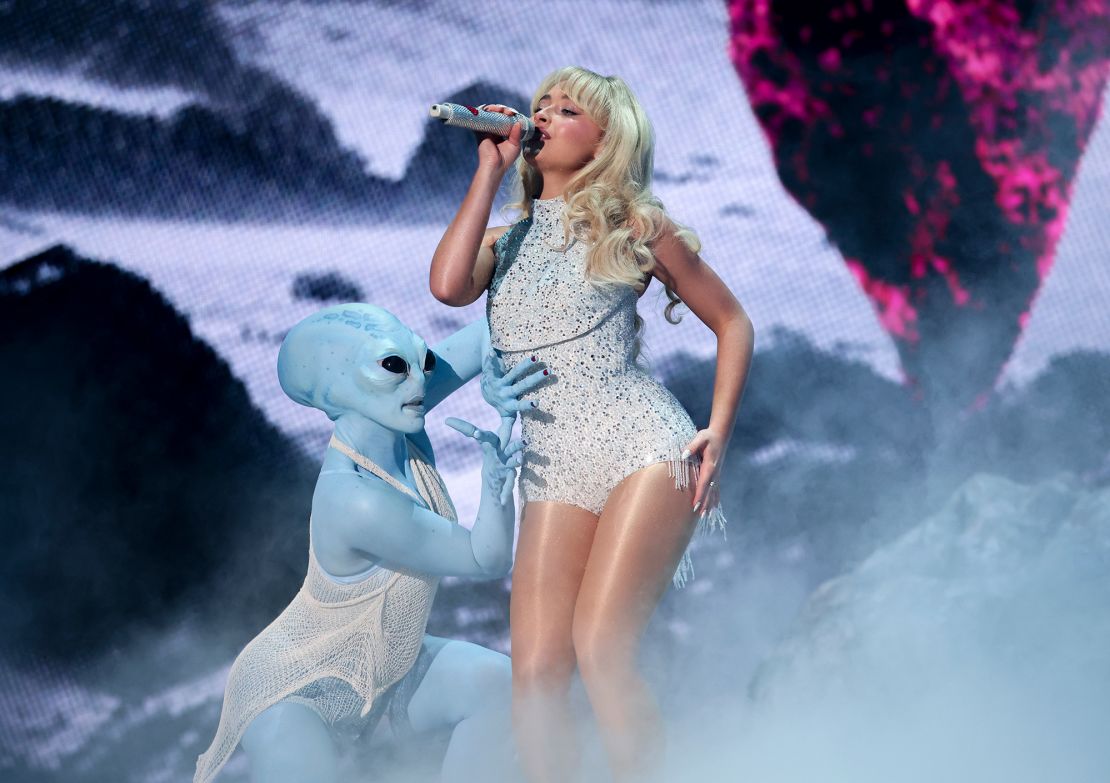For his Fall-Winter 2025 show at Paris Fashion Week, Dutch designer Duran Lantink continued to break the mold with his offbeat designs. Set in an office space that wouldn’t look out of place in the science fiction thriller “Severance,” the collection featured silhouettes with warped proportions, as well as eye-catching styles that included zany animal prints and butt-revealing jeans.
But it was two prosthetic torsos that stole the show. First, was a chiseled six-pack sported by model Mica Argañaraz. Then came the buxom climax: Chandler Frye, an emerging male model, wore a pair of big, bouncing breasts.
Videos of Lantink’s outrageous antics racked up millions of views on social media as commenters argued over whether it championed gender-fluidity or ridiculed femininity. For Lantink, it was about toying with the idea of humans as dolls. “I love the idea of women as action figures,” he wrote in the show notes.
Perhaps so, but it also tapped into a growing trend on the runways: prosthetics. In recent seasons, fashion brands including Martine Rose, Collina Strada and Balenciaga have used implants, masks and 3D makeup techniques to transform models into animals, aliens and cyborgs. Most memorably, Stockholm-based fashion label Avavav, known for its madcap latex creations, made a wearable replica of Kim Kardashian’s backside out of silicone.
“(Designers are using) prosthetics to challenge beauty norms and explore transformation and identity, creating a broader cultural narrative,” said Tanya Noor, a course leader of Hair, Makeup and Prosthetics for Performance undergraduate program at London College of Fashion, over an email.
Striking, lifelike results
The oldest known medical prosthetics (two artificial toes) date back to ancient Egypt, where they were used as walking aids. Approximately 300 years later, in 300BC, came the first known prosthetic leg; made from bronze and wood, it was thought to have been worn by a Roman nobleman. Following the American Civil War in 1860, more advanced wooden limbs with rubber cushioning were created to meet the needs of new amputees.
Then, prosthetics were adopted for the purpose of art and entertainment. At the dawn of cinema, in 1895, prosthetics were created through a crude concoction of materials including gum, cotton and wax. By the 1930s, the invention of foam latex saw rubber masks become commercially available for the first time thanks to prop maker Don Post, earning him the moniker “The Godfather of Halloween.” For the first time, lifelike faces were readily available for both performers and punters. Elsewhere, prosthetics came to play a key role in the art form of drag, where performers use prosthetic breastplates and hip pads to show varying forms of femininity.

Today, the results are more striking than ever: the 2024 horror film “The Substance” won an Oscar for the prosthetics worn by actors Demi Moore and Margaret Qualley to achieve visceral looks (though Qualley later revealed that the prosthetics caused her skin damage that took a year to recover).
They’ve become a bigger part of red carpet fashion, too. Malina Stearns, a special effects makeup artist, masterminded Doja Cat’s look at the 2023 Met Gala, where the popstar embodied Karl Lagerfeld’s beloved cat in a custom Oscar de la Renta gown and facial prosthetics. Stearns has also worked with musicians on other creations including the alien that featured in Sabrina Carpenter’s 2024 VMAs performance, SZA’s bug-eyed album cover and the crocodile-inspired cheeks and chest pieces worn by Doechii.
Lantink isn’t the only one to use prosthetics to subvert gender norms, either. “I’ve applied many fake boobs to men and vice versa,” Stearns said, over email.
On and off the runway
While materials such as latex are still industry standard when it comes to prosthetics, 3D scanning and printing is allowing for even more complex creations. And fashion, increasingly taking cues from the world of entertainment, is now raiding its props department.
In 2019, Balenciaga worked with makeup artist Inge Grognard to create extremely accentuated cheekbones and pouts on the models who walked its runway show. Visual artist and photographer Nadia Lee Cohen used an array of prosthetics, wigs and costumes to change into 33 characters for her 2022 “HELLO My Name Is” project, as she reimagined the person behind each name tag found in a thrift shop. Meanwhile, drag queen Alexis Stone regularly attends Paris Fashion Week as a different celebrity doppelganger each season (most recently, she transformed into Adele, a process which took six weeks of research, sculpting and makeup).

A longtime proponent of prosthetics, makeup artist and entrepreneur Isamaya Ffrench has turned models into elfin-eared creatures for Burberry; extraterrestrials for Paco Rabanne; and animals for Collina Strada. “The (Spring-Summer 2023) show was about breaking down the artificial barriers we put up between ourselves and the planet. So, the idea of transforming models into these hybrid human-animals just felt right,” said Collina Strada’s founder Hillary Taymour over email.
The prosthetics were purchased from a props studio, and then hand-painted and pierced, to “feel organic and slightly uncanny,” said Taymour. She had hoped for them to be “wearable in a high-fashion way” and not come across as gimmicky or party shop fodder. “These weren’t just masks; they were full-on transformations,” she said.
Artistic expression, or something more?
When used in fashion, prosthetics have served as commentary on a reality where fillers and facelifts have become more commonplace. Martine Rose sent models with fake noses down the runway at Milan Fashion Week last June in a bid to challenge Eurocentric beauty standards. “The first thing you see in people is often their nose. And it is often the first thing they change about themselves,” she told Vogue.
However, Stearns observed that while a “plastic surgery look is always popular and people want to enhance (their appearance),” the rise of prosthetics in fashion may have more to do with “art than cosmetics.” While cosmetics procedures are typically undertaken discreetly to enhance or conceal features, the prosthetics used on the runway are frequently designed to be noticed — a key draw for designers vying to create standout, scroll-stopping moments. “The desire to create eye-catching content and viral moments lends itself well to the combination of fashion and prosthetics,” Noor said.
Taymour views prosthetics as a canvas for artistic expression. “Fashion has always been about identity play, but prosthetics take it to another level,” she said. “They let us completely rewrite the human form — why stop at styling clothes when you can style bodies?”

Mollie Gibb, a lecturer of the aforementioned hair, makeup and prosthetics course in London, echoed this sentiment, saying that prosthetics are a way for hair and makeup artists to create looks “in line with the statements that the clothes are making.”
Some practical and progressive solutions have appeared on the runway. Alexander McQueen’s Spring-Summer 1999 show featured a Paralympic athlete and double amputee wearing carved prosthetic legs. More recently, emerging designer Zhongzhi Ding created jeans with a built-in penis (complete with a workable urethral) made from sponge. They were inspired by Tom of Finland, an artist known for creating highly masculinized homoerotic art, and aimed at transgender men who want to wear gender-affirming clothing.
Ding linked the rising interest in prosthetics to body image anxiety. Over email, he shared his belief that “in the future, (there will be) a demand for prosthetics targeting more body parts.” For the most part, though, prosthetics in fashion remain a work of fantasy over utility.
Taymour thinks there’s scope for prosthetics to “go beyond just the face and hands” and “be used in full silhouette transformations” that also include dynamic movement. “Right now, a lot of prosthetics are static, but imagine if they had animatronics or soft robotics built in — like a dress that breathes or a tail that sways,” she mused. “Fashion should always have a sense of fantasy, so let’s take it even further.”




